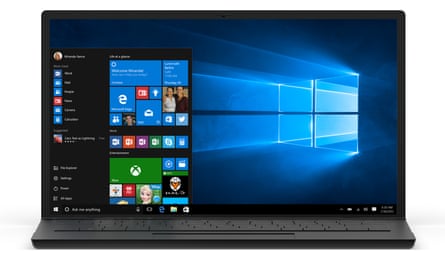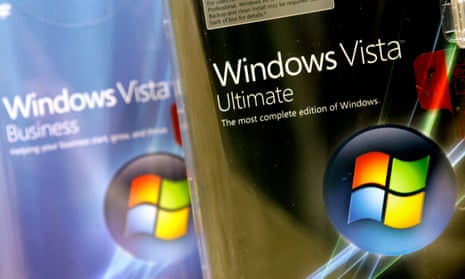I have a Compaq Presario CQ60-215DX. Can I upgrade from Vista to Windows 7 or 10? Leslie
Microsoft will stop supporting Windows Vista on 12 April, so you have less than a month to decide what to do. The short answer is, yes, you can upgrade from Vista to Windows 7 or to the latest Windows 10. Whether it’s worth it is another matter.
The Guardian’s product and service reviews are independent and are in no way influenced by any advertiser or commercial initiative. We will earn a commission from the retailer if you buy something through an affiliate link. Learn more.
The main consideration is the hardware. PC manufacturers installed Vista from 2006 to 2009, so most of these machines will be eight to 10 years old. They are likely to have low specifications, by today’s standards, and their ageing hard drives are increasingly likely to fail. Users could upgrade these PCs to 4GB of memory and replace their hard drives with SSDs to prolong their life, but in many cases, it’s not worth it. They could buy something newer on eBay, or get a refurbished machine from a supplier such as Tier1online.
Bear in mind that doing hardware and software upgrades can involve quite a lot of work with an uncertain outcome. That’s fine for PC hobbyists, but if you were that sort of person, you wouldn’t be using Vista. In fact, you probably wouldn’t have bought a Presario CQ60-215DX. If yours has a dual-core AMD Athlon X2 QL-62 processor, it will be slow. If it has a single-core Sempron, it belongs in the bin.

People who have faster or newer Vista laptops should find they run better under Windows 10. The minimum useful spec is something like a 2.4GHz Core 2 Duo T8300 and 4GB of memory. This processor has a PassMark CPU score of 1482. Search for your CPU’s score at PassMark and see if it’s higher. If it’s much lower, drop the idea. Life’s too short.
If in doubt about Windows 10, try it for free. Anyone can install it at zero cost simply by not activating it (if you can cope with the nagging to buy it): see below.
You could also try installing a version of Linux, such as Mint 18.1, which is free. (If you have problems getting the Wireless LAN card to work, this might help.)
Linux is not directly compatible with programs such as Microsoft Office, Adobe Creative Suite, Apple iTunes and other mainstream software. Check to see whether you will be able to run all your essentials on Linux, or find usable replacements.
Either way, make a clone of your hard drive first, so that you can go back to Vista if Windows 7/10/Linux doesn’t work properly.
From Vista to Windows 7
If I upgrade to Windows 7, do I need to upgrade my programs etc first? Lynn
The upgrade from Vista to Windows 7 is what Microsoft calls “an in-place upgrade”. All your current programs and data should stay the same as they were before. It is, of course, important to back up your PC and all your data first, because things sometimes go wrong.
Make sure that Vista is patched and up-to-date before upgrading. You could also update all your PC’s drivers to the latest versions – there’s some help online – and check your PC manufacturer’s website for Rom upgrades. However, you don’t need to upgrade your programs.
Windows 7 is no longer the current version, and there are scammers selling pirate copies, so caveat emptor. You will need to buy a version that is as good as or better than your current version of Vista. For example, you can upgrade from Vista Home Basic to Windows 7 Home Basic, Home Premium or Ultimate. However, you cannot go from Vista Home Premium to Windows 7 Home Basic. See Windows 7 Upgrade Paths for more details.
Further, in-place upgrades have to go from 32-bit to 32-bit versions, or from 64-bit to 64-bit versions, not from 32-bit to 64-bit versions, or vice versa. You can upgrade from 32-bits to 64-bits – this is a good idea – but only by doing a “clean installation” that removes all your current software and data. To do this, select the Custom option instead of the usual Upgrade option.
One problem with upgrading to Windows 7 is that the DVD versions are now many years out of date. Once you’ve installed it, you have to download hundreds of updates, and many of them force reboots. The last time I did a clean installation of Windows 7, it was still installing updates three days later.
Either way, I don’t recommend upgrading to Windows 7 today, unless it’s a stepping stone to Windows 10. Windows 10 is much better than Windows 7, and it’s improving all the time. Also, Windows 7 reaches the end of its life in 2020, though you may need to buy a new PC before then.
Upgrading to Windows 10
I have a decent PC running Vista – fast processor, 8GB of memory. Is there an easy way to wipe it clean and do a new install of Windows 10? I have my data files backed up. Tim
You cannot do an in-place upgrade from Vista to Windows 10, and therefore Microsoft did not offer Vista users a free upgrade. However, you can certainly buy an upgrade to Windows 10 and do a clean installation. (In fact, it doesn’t matter which way round you do it. You can install Windows 10 first and then go to the online Windows Store to pay for it.)
You don’t need to wipe your current copy of Vista: the clean installation will take care of it.

To do a clean installation, you can either follow Microsoft’s instructions and create a DVD or thumbdrive, or you can buy a retail copy. (With retail copies, you can remove a copy of Windows from one PC and install it on another. You can’t do that with pre-installed versions, which are locked to the hardware on which they are first installed.)
Technically, it’s too late to get a free upgrade from Windows 7 or 8/8.1 to Windows 10. However, even after last year’s deadline, Microsoft kept providing upgrades when users typed in their Windows 7 product keys. That may still work. Also, Microsoft has left a loophole by offering free upgrades to people who need assistive technologies such as screen readers. This could obviously be withdrawn at any time.
Alternatively, you could get a free copy of Windows 10 by joining Microsoft’s Insider testing program and do a clean installation of that.
Finally, you could skip past the product key screens and use Windows 10 without activating it. Some features are limited, it puts a watermark on your desktop and it will nag you to buy a copy, but it’s still a vast improvement on Vista and costs the same as Linux (ie: nothing).
Of course, Microsoft could clamp down on non-activated copies one day. However, Microsoft wants people to move to Windows 10 so, at the moment, it’s putting adoption ahead of profits. And once you’ve installed Windows 10, all future upgrades are free.
Have you got another question for Jack? Email it to Ask.Jack@theguardian.com

Comments (…)
Sign in or create your Guardian account to join the discussion